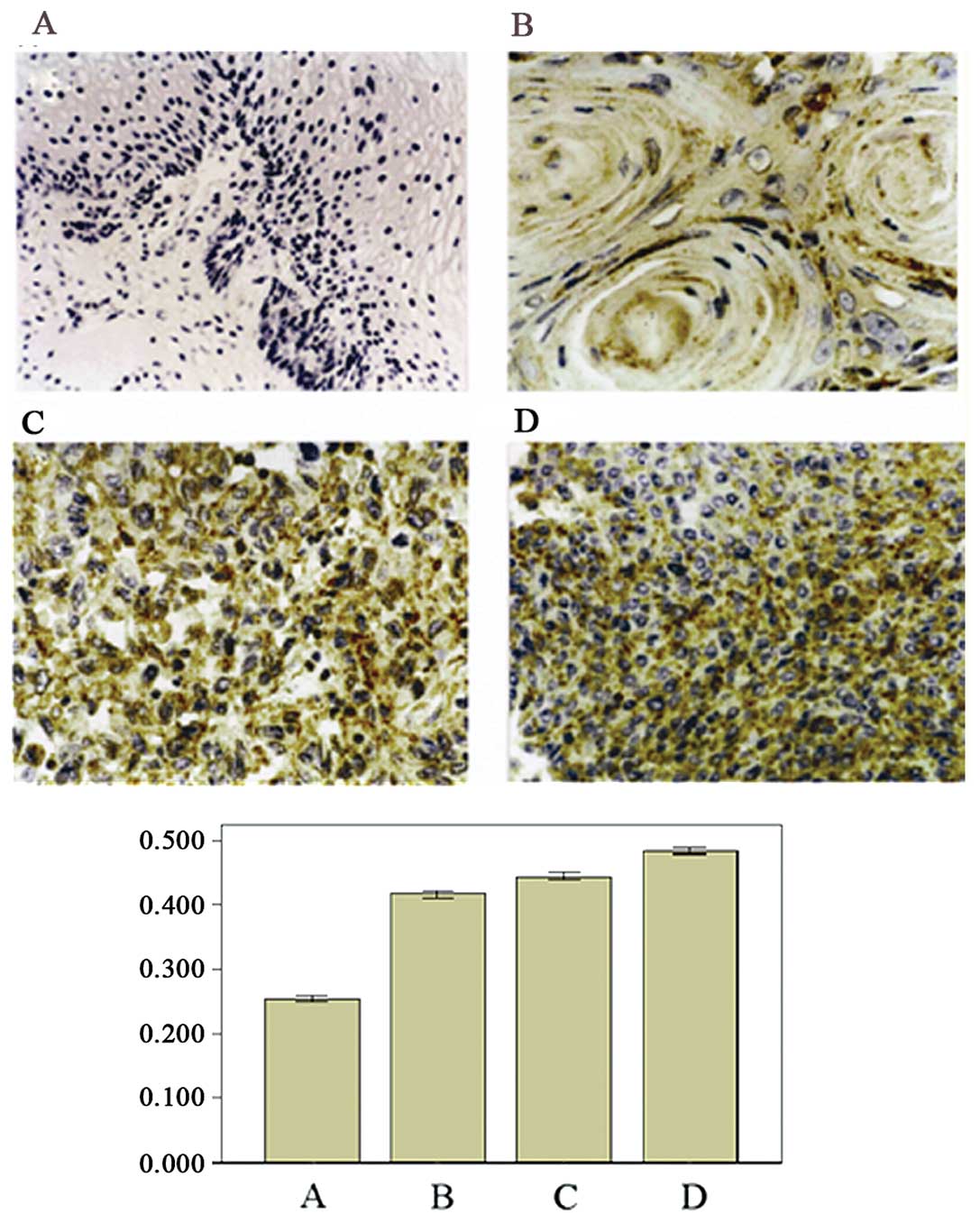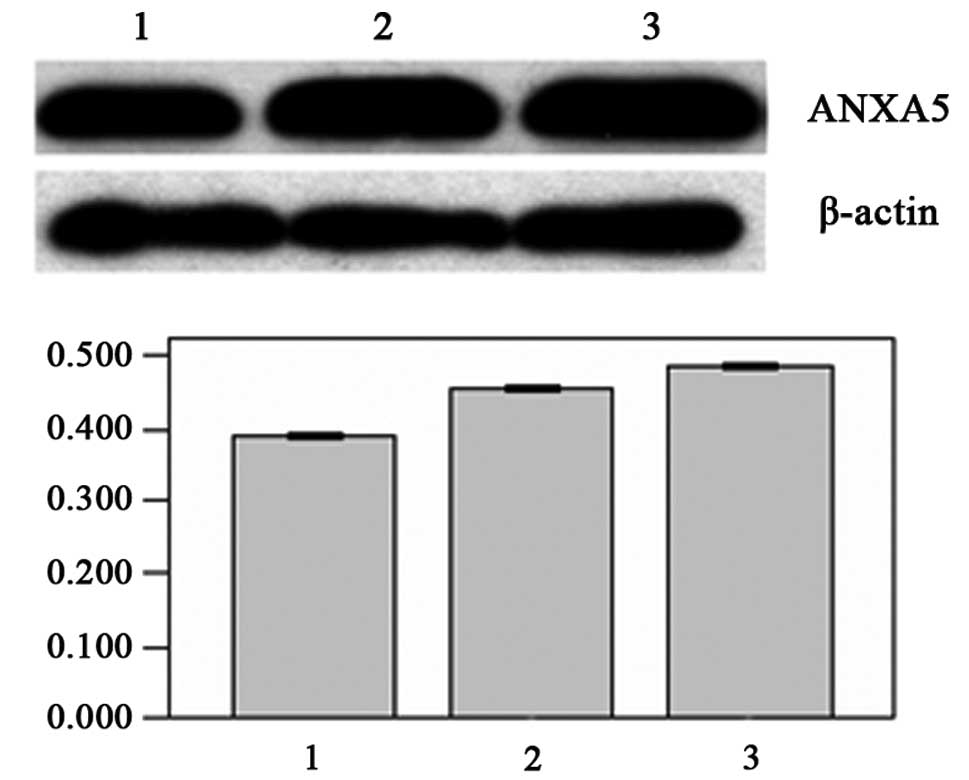|
1
|
Greenlee RT, Hill-Harmon MB, Murray T and
Thun M: Cancer statistics. CA Cancer J Clin. 51:15–36. 2001.
|
|
2
|
Mortimer JC, Laohavisit A, Macpherson N,
Webb A, Brownlee C, Battey NH and Davies JM: Annexins:
multifunctional components of growth and adaptation. J Exp Bot.
59:533–544. 2008. View Article : Google Scholar : PubMed/NCBI
|
|
3
|
Camors E, Monceau V and Charlemagne D:
Annexins and Ca2+ handling in the heart. Cardiovasc Res.
65:793–802. 2005. View Article : Google Scholar : PubMed/NCBI
|
|
4
|
Russo-Marie F: Annexin V and phospholipid
metabolism. Clin Chem Lab Med. 37:287–291. 1999. View Article : Google Scholar : PubMed/NCBI
|
|
5
|
Gerke V and Moss SE: Annexins: from
structure to function. Physiol Rev. 82:331–371. 2002.PubMed/NCBI
|
|
6
|
Rand JH, Wu XX, Quinn AS and Taatjes DJ:
The annexin A5- mediated pathogenic mechanism in the
antiphospholipid syndrome: role in pregnancy losses and thrombosis.
Lupus. 19:460–469. 2010. View Article : Google Scholar : PubMed/NCBI
|
|
7
|
Kenis H, van Genderen H, Deckers NM, Lux
PA, Hofstra L, Narula J and Reutelingsperger CP: Annexin A5
inhibits engulfment through internalization of PS-expressing cell
membrane patches. Exp Cell Res. 312:719–726. 2006. View Article : Google Scholar : PubMed/NCBI
|
|
8
|
Kim DM, Noh HB, Park DS, Ryu SH, Koo JS
and Shim YB: Immunosensors for detection of Annexin II and MUC5AC
for early diagnosis of lung cancer. Biosens Bioelectron.
25:456–462. 2009. View Article : Google Scholar : PubMed/NCBI
|
|
9
|
Califano J, van der Riet P, Westra W, et
al: Genetic progression model for head and neck cancer:
implications for field cancerization. Cancer Res. 56:2488–2492.
1996.PubMed/NCBI
|
|
10
|
Hattori T, Hoffman T and Hirata F:
Differentiation of a histiocytic lymphoma cell line by lipomodulin,
a phospholipase inhibitory protein. Biochem Biophys Res Commun.
111:551–559. 1983. View Article : Google Scholar : PubMed/NCBI
|
|
11
|
Duncan R, Carpenter B, Main LC, Telfer C
and Murray GI: Characterisation and protein expression profiling of
annexins in colorectal cancer. Br J Cancer. 98:426–433. 2008.
View Article : Google Scholar : PubMed/NCBI
|
|
12
|
Kim JK, Kim PJ, Jung KH, et al: Decreased
expression of annexin A10 in gastric cancer and its overexpression
in tumor cell growth suppression. Oncol Rep. 24:607–612.
2010.PubMed/NCBI
|
|
13
|
Zhao P, Zhang W, Tang J, et al: Annexin II
promotes invasion and migration of human hepatocellular carcinoma
cells in vitro via its interaction with HAb18G/CD147. Cancer Sci.
101:387–395. 2010. View Article : Google Scholar : PubMed/NCBI
|
|
14
|
Liu YF, Xiao ZQ, Li MX, et al:
Quantitative proteome analysis reveals annexin A3 as a novel
biomarker in lung adenocarcinoma. J Pathol. 217:54–64. 2009.
View Article : Google Scholar : PubMed/NCBI
|
|
15
|
Zhang Z, Huang L, Zhao W and Rigas B:
Annexin 1 induced by anti-inflammatory drugs binds to NF-kappaB and
inhibits its activation: anticancer effects in vitro and in vivo.
Cancer Res. 70:2379–2388. 2010. View Article : Google Scholar : PubMed/NCBI
|
|
16
|
Torosyan Y, Dobi A, Glasman M, et al: Role
of multi-hnRNP nuclear complex in regulation of tumor suppressor
ANXA7 in prostate cancer cells. Oncogene. 29:2457–2466. 2010.
View Article : Google Scholar : PubMed/NCBI
|
|
17
|
Mulla A, Christian HC, Solito E, Mendoza
N, Morris JF and Buckingham JC: Expression, subcellular
localization and phosphorylation status of annexins 1 and 5 in
human pituitary adenomas and a growth hormone-secreting carcinoma.
Clin Endocrinol (Oxford). 60:107–119. 2004. View Article : Google Scholar
|
|
18
|
Dooley TP, Reddy SP, Wilborn TW and Davis
RL: Biomarkers of human cutaneous squamous cell carcinoma from
tissues and cell lines identified by DNA microarrays and qRT-PCR.
Biochem Biophys Res Commun. 306:1026–1036. 2003. View Article : Google Scholar : PubMed/NCBI
|
|
19
|
Wehder L, Arndt S, Murzik U, Bosserhoff
AK, Kob R, von Eggeling F and Melle C: Annexin A5 is involved in
migration and invasion of oral carcinoma. Cell Cycle. 8:1552–1558.
2009. View Article : Google Scholar : PubMed/NCBI
|
|
20
|
Karube A, Shidara Y, Hayasaka K, Maki M
and Tanaka T: Suppression of calphobidin I (CPB I) production in
carcinoma of uterine cervix and endometrium. Gynecol Oncol.
58:295–300. 1995. View Article : Google Scholar : PubMed/NCBI
|
|
21
|
Bae SM, Min HJ, Ding GH, et al: Protein
expression profile using two-dimensional gel analysis in squamous
cervical cancer patients. Cancer Res Treat. 38:99–107. 2006.
View Article : Google Scholar : PubMed/NCBI
|
|
22
|
Guzmán-Aránguez A, Olmo N, Turnay J,
Lecona E, Pérez-Ramos P, López de Silanes I and Lizarbe MA:
Differentiation of human colon adenocarcinoma cells alters the
expression and intracellular localization of annexins A1, A2, and
A5. J Cell Bioche. 94:178–193. 2005.PubMed/NCBI
|
|
23
|
Xue G, Hao LQ, Ding FX, et al: Expression
of annexin a5 is associated with higher tumor stage and poor
prognosis in colorectal adenocarcinomas. J Clin Gastroenterol.
43:831–837. 2009. View Article : Google Scholar : PubMed/NCBI
|
|
24
|
Lomnytska MI, Becker S, Hellman K, et al:
Diagnostic protein marker patterns in squamous cervical cancer.
Proteomics Clin Appl. 4:17–31. 2010. View Article : Google Scholar : PubMed/NCBI
|














